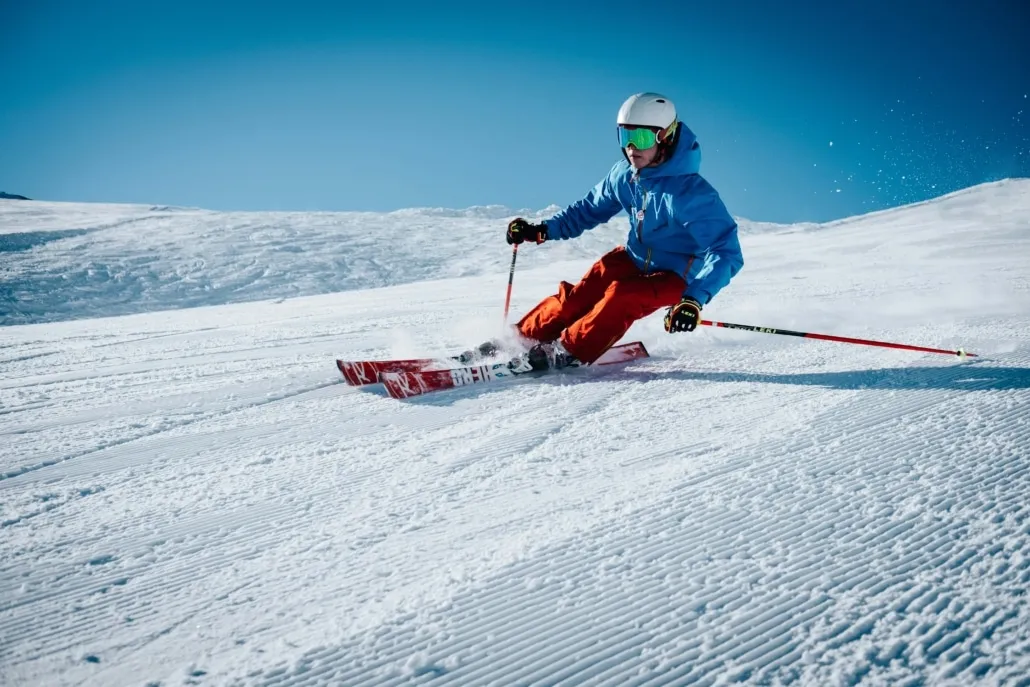Skiing is an exhilarating winter sport, attracting millions worldwide. The feeling of gliding down snow-covered slopes, breathing in the fresh mountain air, is truly an unforgettable experience. However, for beginners, getting started with this sport can be challenging. This article provides the most useful information to help you begin your skiing journey safely and enjoyably, focusing on beginner-friendly ski resorts.
Gear Up for Safety: Essential Equipment
Before hitting the slopes, preparing the right gear is crucial. Ski clothing and equipment not only keep you warm but also ensure safety and comfort throughout your practice and fun.
Choosing Ski Clothing
The most important principle when choosing ski clothing is layering. This allows you to easily adjust your body temperature according to weather conditions.
- Base Layer: Choose moisture-wicking materials to keep your body dry.
- Mid Layer: Fleece jackets or down jackets help insulate and keep you warm.
- Outer Layer: Waterproof and windproof ski jackets and pants are essential.
Don’t forget other important accessories like gloves (or mittens), a beanie, and specialized ski socks.
Ski Boots and Bindings
Ski boots should fit snugly but not too tight or too loose. Make sure the boots are in good condition and the bindings are adjusted properly to ensure safety while skiing.
Skis and Ski Poles
For beginners, shorter skis are easier to control. When choosing ski poles, ensure the length is appropriate: when you hold the poles upright, your elbows should be at a 90-degree angle.
Helmet and Other Protective Gear
A helmet is indispensable for skiing, protecting your head from hard impacts. Additionally, you should equip yourself with other protective gear such as ski goggles, knee pads, and elbow pads.

Basic Skills: A Solid Foundation to Start
Once you have the right gear, you need to master basic skills to move safely and confidently on the slopes.
Proper Ski Stance
Stand upright, knees slightly bent, with your weight evenly distributed between your feet. Keep your shoulders and hips aligned. This stance helps you maintain better balance and control your skis more easily.
Turning and Stopping Techniques
To turn, shift your weight to the side you want to turn, while bending your knees and applying slight pressure to the inside edge of the ski. To stop, widen your skis into a V-shape and apply pressure to the inside edges of both skis.
Speed Control
When starting out, practice controlling your speed by keeping your skis in a V-shape (also known as the “pizza” or “wedge” technique). To increase speed, bring your skis closer together.
Falling and Getting Up Safely
Falling is inevitable when learning to ski. When falling, try to relax your body and avoid using your hands to brace yourself. To get up, lie on your stomach, use your poles and skis to create leverage, and slowly stand up.
Safety First: Skiing Rules and Etiquette
Just like when driving, you need to follow safety rules and skiing etiquette to ensure safety for yourself and others around you.
Understand Mountain Signs and Symbols
Mountain signs and symbols provide important information about terrain, trail difficulty, and potential hazards. Take time to familiarize yourself with them before you start skiing.
Ski Lift and Trail Etiquette
When queuing for ski lifts, follow staff instructions and be considerate of others. On the slopes, always yield to skiers ahead of you and look carefully before entering a trail.
Respect Other Skiers
Maintain a safe distance from those around you and always help those in need.
Choosing the Right Ski Resort for Beginners
Choosing the right ski resort is key to having a safe and enjoyable skiing experience. Here are some important criteria to consider:
- Terrain: Choose a ski resort with plenty of beginner-friendly slopes, with gentle gradients and well-groomed snow surfaces.
- Support Services: Prioritize ski resorts with professional ski instruction services to help you learn basic techniques and improve your skills.
- Facilities: Ensure the ski resort has all necessary amenities such as ski rental areas, restaurants, rest areas, and a rescue station.
Here are a few suggestions for beginner-friendly ski resorts:
- The Alps, Europe: Many famous ski resorts like Avoriaz (France) and Zermatt (Switzerland) have separate areas for beginners with lessons and easy slopes.
- Aspen, Colorado, USA: The Buttermilk area is renowned for its beginner-friendly terrain, with gentle slopes and excellent ski schools.
- Niseko, Hokkaido, Japan: This resort is famous for its high-quality powder snow and ski lessons for all levels, including beginners.
Preventing Injuries and Staying Safe
Skiing can cause unexpected injuries if you are not careful. Here are some preventive measures you should follow:
- Warm up thoroughly before skiing: Warming up your muscles helps reduce the risk of injury.
- Ski within your ability: Do not attempt slopes that are too difficult if you are not experienced enough.
- Stay hydrated: Keeping your body hydrated helps you maintain focus and reduces the risk of cramps.
- Get enough rest: Fatigue can lead to mistakes and increase the risk of accidents.
Prepare for Emergencies
No matter how well prepared you are, accidents can still happen. Therefore, always be prepared for emergency situations.
Carry a Phone and Emergency Contact Numbers
Always carry a fully charged mobile phone and have emergency contact numbers saved.
Know the Location of the Rescue Station
Find out the location of rescue stations on the mountain so you can quickly seek help when needed.
Understand Ski Patrol Procedures
Ski patrol personnel are always ready to help those in need. If you or someone else needs assistance, contact them immediately.
Conclusion
Skiing is a fantastic sport that offers unforgettable experiences. By equipping yourself with the necessary knowledge and skills, you can fully enjoy the fun of this sport safely and confidently. Choose beginner-friendly ski resorts, follow safety rules, and always respect those around you. Have a fun and memorable skiing trip!